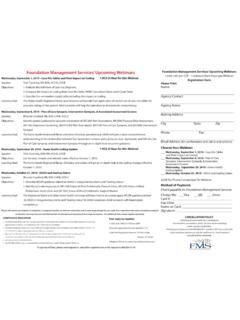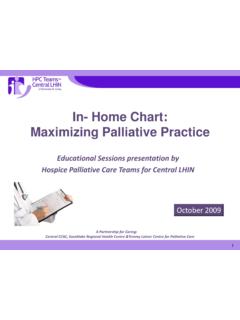Transcription of Wound Management Comprehensive - - RN.org®
1 Wound Management Comprehensive Reviewed September, 2016, Expires November, 2018 Provider Information and Specifics available on our Website Unauthorized Distribution Prohibited 2016 , , , LLC By Wanda Lockwood, RN, BA, MA Introduction There are many different types of wounds (burns, ulcers, dermal lesions, surgical incisions, traumatic injuries), and these wounds may be classified or staged differently, with some (such as burns) requiring special treatment, but there are general principles of Wound assessment and Management that apply to all different types of wounds. Since the days of the simple wet to dry saline dressings, Wound care has changed markedly. There are different dressings and Wound materials available to manage exudate, debride the Wound , decrease bioburden, decrease pain, and promote granulation. Understanding the skin is necessary for assessing and treating wounds.
2 The skin provides protection and immunity, sensation, and thermoregulation. The skin is also involved in metabolism as it synthesizes vitamin D, necessary for the metabolism of calcium and phosphate. Additionally, the skin is critical for the individual s body image. National Cancer Institute Epidermis Outer avascular layers of skin with a basement membrane separating it from the dermis. The epidermis regenerates every 4 to 6 weeks. The basal layer contains melanocytes, which provide pigmentation and protection from sunlight. Basement membrane zone (BMZ) Between the epidermis and dermis. It provides support for the epidermis. Dermis Below the BMZ. It contains nerves, sebaceous glands, sweat glands, hair follicles, lymphatic vessels, veins and arteries. Fibroblasts produce the primary proteins of this layer, collagen and elastin. The dermis also contains mast cells, macrophages, and lymphocytes, all involved in the skin immune system.
3 Hypodermis Subcutaneous tissue below the dermis, providing vasculature, cushioning, and insulation. Assessment Initial assessment must comprise a complete physical assessment and history. The patient s medical history can provide useful information about issues such as tissue perfusion, circulatory impairment edema, infection, chronic illness (such as diabetes, cancer, autoimmune disorders), skin abnormalities (scarring, radiation changes, dermatitis), and stress. Some medications, such as chemotherapy or corticosteroids, may contribute to skin breakdown or delay healing. The Wound history should be detailed and include history of previous wounds and any difficulty or delay in healing. For the current Wound , the patient should be questioned about the cause of the Wound , the duration, any treatments done and the type of diagnostic testing, such as vascular studies, imaging studies, biopsies, and cultures, done related to the Wound .
4 When assessing the skin, age is an important consideration. Wikimedia Commons, Azoreg An infant s skin is thinner than an adult s. The epidermis is fully developed, but the dermis layer is only about 60% of that of an adult. Thus, the infant s skin is soft and hair is fine. The dermis layer develops as the child grows. During adolescence, the hair follicles activate and the thickness of the dermis decreases about 20% and epidermal turnover time increases, so healing slows. As people continue to age, Langerhans cells decrease in number, making the skin more prone to cancer, and the inflammatory reactions decrease. The sweat glands, vascularity, and subcutaneous fat all decrease, interfering with thermoregulation and contributing to dryness and irritation of the skin. The epidermal-dermal junction, the BMZ, flattens, resulting in skin prone to tearing. The elastin in the skin degrades from the combination of aging and exposure to ultraviolet rays of the sun.
5 The thinning of the hypodermis can lead to pressure ulcers. Wound assessment should include notations of the following: Measurements (length, width, depth) The Wound should be measured in centimeters at its widest points for length and width. Depth can be measured by inserting a sterile swab into the Wound and marking the depth or using special Wound measuring instruments. Undermining Damaged tissue underneath intact skin, usually about the perimeter of the Wound . If this tissue is open, it can be measured by insertion of a sterile swab. In some cases, the tissue is damaged but intact; however, the tissue may feel very spongy on palpation. Undermining should be reported according to its relation to the open Wound by reference to a clock face: Undermining of cm width extends from 2 o clock to 4 o clock. Tunneling Extends from the Wound under normal tissue but does not open to the skin or other structures.
6 If the tunnel is of adequate diameter and position, a sterile swab may be inserted to measure length. Described by reference to clock face. Fistula Similar to tunneling but connects two structures, such as from the Wound to an organ or the Wound to the skin. Described by reference to clock face. Abscess Localized collection of purulent material (often associated with fistulae). Area above is usually swollen, inflamed, and painful, but deep abscesses, such as in an organ, may be difficult to assess by observation and palpation alone. Wound appearance All aspects of the Wound should be noted: granulation, necrotic tissue, eschar, inflammation, slough, and exposure of underlying tissue, such as muscles, ligaments, or bone. Drainage The amount, odor and type of exudate (serous, purulent, sanguinous, serosanguineous) should be noted. Periwound The area about the Wound should be carefully palpated and assessed for maceration, scarring, irritation, rash, and fluctuance.
7 Pain The degree and type of pain should be described. The patient can use the 1 to 10 scale or other scale according to age and mental ability. Wound classification Systems A number of different classification systems are in common use, depending on the type of Wound . Degree Burns are typically classified according to degree of injury: First-degree Superficial and affect the epidermis only (sunburn). Second-degree Extend through the dermis and involve blistering. Third-degree Extend through the dermis and into underlying tissue, including vasculature, muscles, and nerves. Thickness Describing wounds by thickness is similar to classifying by degrees, but it is less specific than the degree classification for burns and can include different types of wounds, such as ulcers and traumatic injuries as well as burns. Partial thickness Wounds involve the epidermis and may extend into the dermis but not through it, so that the vessels and glands that provide nutrients and repair skin are intact.
8 Bleeding activates hemostasis and temporarily provides a barrier to bacteria. Coagulation occurs and fibrin is formed with the clot sealing disrupted vessels. This is followed by fibrinolysis, during which the clot breaks down and repair begins with the inflammatory stage. Wounds usually heal within about 2 weeks. Typical partial thickness wounds include blisters, skin tears, and first or second degree burns. Full thickness Wounds, which may be acute or chronic, extend through the dermis and into the subcutaneous layer or below into the muscle or even to the bone. Full-thickness wounds may heal by primary or secondary intention. Examples of wounds healing by secondary intention include dehisced surgical wounds and those resulting from underlying morbidities that interfere with normal healing. Bleeding and hemostasis do not occur with healing by secondary intention, so the healing process is compromised.
9 Typical full thickness wounds include third degree burns and deep pressure ulcers. National Pressure Ulcer Advisory Panel (2007) Staging System The NPUAP defines a pressure ulcer as a localized injury to the skin and/or underlying tissue usually over a bony prominence, as a result of pressure, or pressure in combination with shear and/or friction. The depth of an ulcer may vary depending on location. For example, a stage III ulcer of the ear has significantly less depth than a stage III ulcer of the hip. Stages include: Suspected deep tissue injury Purple or reddish discolored intact skin or blood blister. Tissue may be boggy, mushy, or firm and temperature may vary from that of adjoining areas. The area may be painful or itchy Stage I Skin is intact with localized non-blanching reddened area, often at areas where pressure is exerted, such as over bony prominences. Darkly pigmented skin may show only a darker change in coloration Stage II Ulcer may appear as an abrasion or blistered area or slightly depressed with red/pink Wound bed without slough.
10 Skin loss is partial-thickness and involves the epidermis and/or dermis. Stage III Deep full-thickness ulceration of skin exposes subcutaneous tissue. Slough may be present. Underlying muscle, tendon, and bone are not visible, but tunneling and undermining may be evident. Stage IV Deep full-thickness ulceration of skin with extensive damage, necrosis of tissue extending to muscle, bone, tendons, or joints. Unstageable The extent of slough and/or eschar at the base of the Wound makes accurate staging impossible until after debridement. Modified Wagner s Foot Ulcer Classification The Modified Wagner Ulcer Classification System divides foot ulcers into six grades, based on lesion depth, osteomyelitis or gangrene, infection, ischemia, and neuropathy. This classification does not include the size of the ulcer, so it cannot be used alone to fully evaluate the ulcer, but it is useful for predicting outcomes.

















